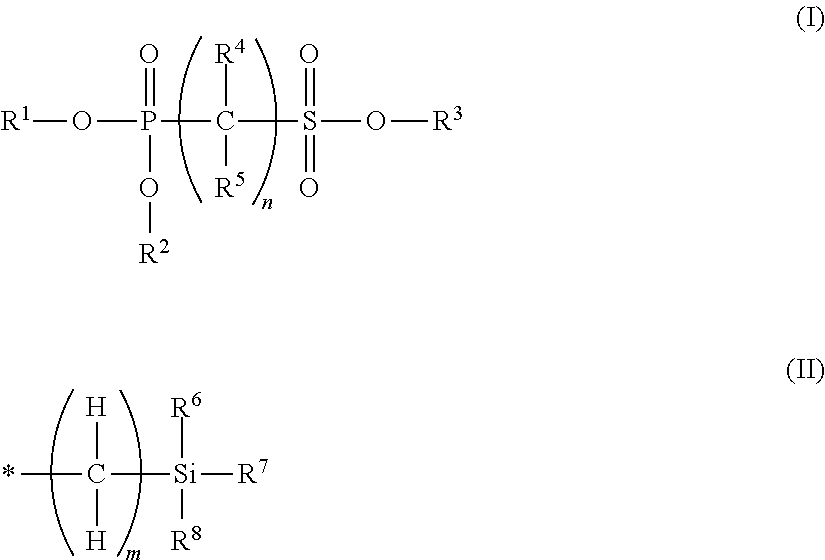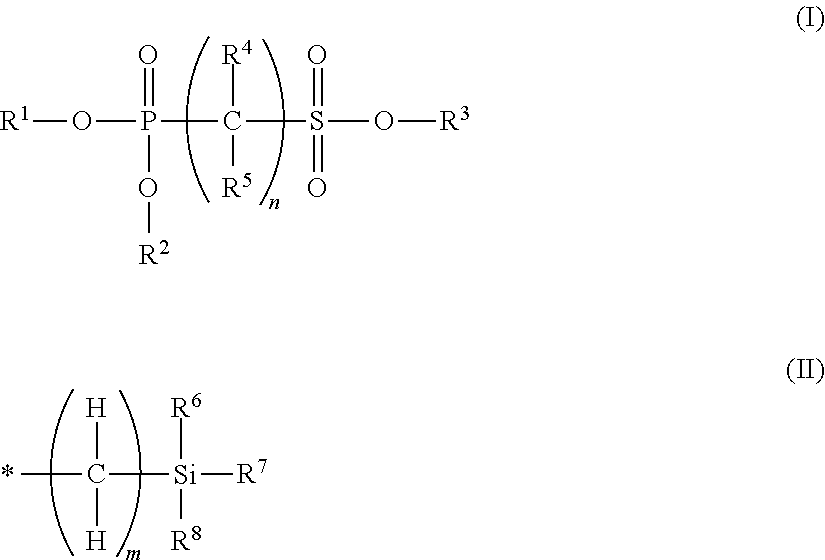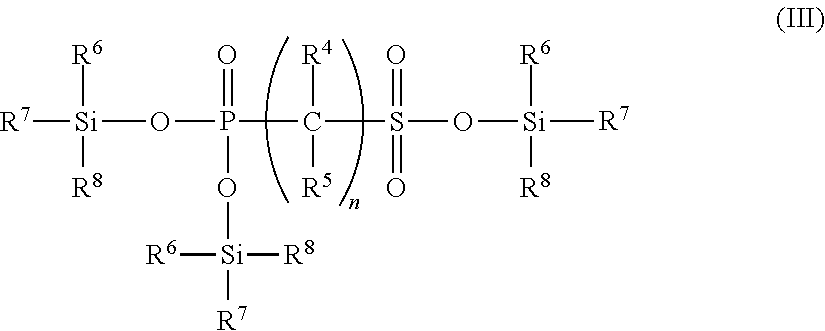Non-aqueous electrolyte solution containing phosphonosulfonic acid compound, and lithium secondary battery
- Summary
- Abstract
- Description
- Claims
- Application Information
AI Technical Summary
Benefits of technology
Problems solved by technology
Method used
Image
Examples
synthesis example 1
Synthesis of Methyl Diethyl Phosphonomethanesulfonate (Exemplary Compound 10)
[0257]Methyl methanesulfonate (5.00 g, 45.4 mmol) was dissolved in tetrahydrofuran (100 ml), n-butyl lithium (1.6 M hexane solution, 31 ml, 49.9 mmol) was dropped into the solution under cooling at −78° C., and stirred for 30 minutes at this temperature. Subsequently, diethylphosphoric acid chloride (3.9 ml, 27.2 mmol) was dropped into the solution, and stirred at −78° C. for 1 hour, and at −50° C. for 30 minutes. A saturated ammonium chloride aqueous solution was added to the reaction liquid and stirred, the mixture was further diluted with water, and then extracted with ethyl acetate twice. The combined extract (organic layer) was washed with water and a saturated saline solution, dried with anhydrous magnesium sulfate, and then concentrated. The oily object thus obtained was purified by silica gel column chromatography (ethyl acetate / hexane system), and thus 5.04 g (yield 75%) of methyl diethyl phosphono...
synthesis example 2
Synthesis of Trimethylsilyl Bis(Trimethylsilyl) Phosphonomethanesulfonate (Exemplary compound 23)
[0259]Methyl diethyl phosphonomethanesulfonate (exemplary compound 10) (5.04 g, 20.5 mmol) was dissolved in methylene chloride (25 ml), and trimethylsilyl bromide (10.8 ml, 80.9 mmol) was added at room temperature. After stirring at room temperature for 6 hours, the reaction liquid was concentrated under reduced pressure, and thus trimethylsilyl bis(trimethylsilyl) phosphonomethanesulfonate (exemplary compound 23) was obtained (7.67 g, yield 95%). The NMR result of the compound thus obtained was as follows.
[0260]1H-NMR (270 MHz, CDCl3) δ (ppm): 3.90 (2H, d, J=18.4 Hz), 0.36 (18H, s), 0.07 (9H, s).
synthesis example 3
Synthesis of Trimethylsilylmethyl Bis(Trimethylsilylmethyl) Phosphonomethanesulfonate (Exemplary Compound 71)
[0261](Process 1)
[0262]In accordance with the method described in Chemische Berichte, 1980, Vol. 113, (1), 142-151, 13.08 g (47%) of (dichlorophosphoryl)methanesulfonyl chloride was obtained from phosphonoacetic acid (16.8 g).
[0263](Process 2) Trimethylsilyl methanol (0.9 ml, 7.13 mmol) and triethylamine (1.5 ml, 10.8 mmol) were dissolved in methylene chloride (20 ml) to make a solution, to which a solution of the above-described (dichlorophosphoryl)methanesulfonyl chloride (0.50 g, 2.16 mmol) in methylene chloride (2 ml) was added under cooling with ice. After stirring for 2 hours under cooling with ice, the reaction liquid was poured into water. The mixture was extracted with methylene chloride. The combined extract (organic layer) was washed with a saturated saline solution, dried with anhydrous magnesium sulfate, and concentrated under reduced pressure. The crude product ...
PUM
 Login to View More
Login to View More Abstract
Description
Claims
Application Information
 Login to View More
Login to View More - R&D
- Intellectual Property
- Life Sciences
- Materials
- Tech Scout
- Unparalleled Data Quality
- Higher Quality Content
- 60% Fewer Hallucinations
Browse by: Latest US Patents, China's latest patents, Technical Efficacy Thesaurus, Application Domain, Technology Topic, Popular Technical Reports.
© 2025 PatSnap. All rights reserved.Legal|Privacy policy|Modern Slavery Act Transparency Statement|Sitemap|About US| Contact US: help@patsnap.com



